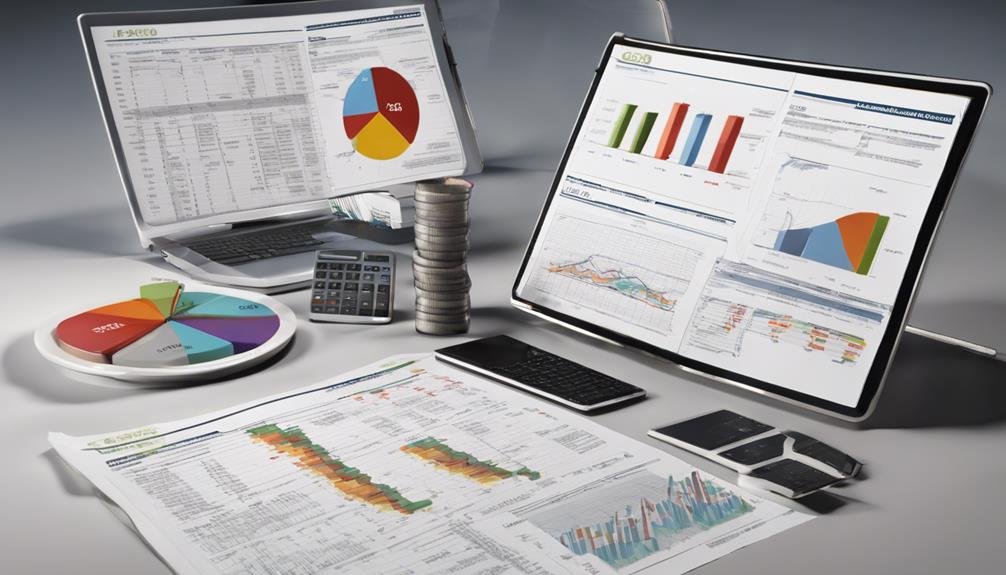IFRS Vs. Gaap: Key Differences and Their Impact on Financial Statements
When comparing IFRS and GAAP, recognize the differences in principles, valuation methods, revenue recognition criteria, treatment of inventory, and financial statement presentation. IFRS leans towards fair value asset valuation, while GAAP relies more on historical cost. Variations in revenue recognition timelines exist, impacting financial statement interpretation. Inventory handled differently, with GAAP allowing LIFO and FIFO methods. Format divergences between IFRS and GAAP affect stakeholder decisions. Understanding these nuances is crucial for accurate financial analysis. Further exploration uncovers deeper insights into their impacts on financial statements.
Key Takeaways
- IFRS is principle-based, GAAP is rule-based, affecting financial statement interpretation.
- IFRS values assets at fair value, while GAAP relies more on historical cost.
- Treatment of inventory differs (LIFO allowed in GAAP, not in IFRS).
- Revenue recognition timing varies between IFRS and GAAP.
- Financial statement presentation formats and disclosure requirements differ between IFRS and GAAP.
History and Evolution
Compare the historical development and progression of IFRS and GAAP to understand their divergent paths in financial reporting standards. The Evolution of Standards for both IFRS and GAAP has been shaped by unique Historical Contexts. IFRS, developed by the International Accounting Standards Board (IASB), traces its roots back to the 1973 formation of the International Accounting Standards Committee (IASC). Over time, the IASC evolved into the IASB, which issued IFRS to promote global financial reporting consistency.
On the other hand, GAAP has a more intricate history, with its origins dating back to the early 20th century in the United States. The Securities and Exchange Commission (SEC) played a pivotal role in its development by setting standards for financial reporting. The Financial Accounting Standards Board (FASB) was established in 1973 to further refine these standards, leading to the detailed framework of GAAP used in the U.S. today. The differing historical contexts of IFRS and GAAP have influenced their evolution and divergence in financial reporting standards.
Scope and Applicability
As financial reporting standards have evolved separately under IFRS and GAAP, an understanding of their distinct scopes and applicability becomes essential to grasp the implications for global financial reporting practices. When considering regulatory requirements, IFRS is more principle-based, focusing on the conceptual framework, whereas GAAP is rule-based, providing specific guidelines for various transactions. This fundamental difference influences the interpretation and application of standards, impacting financial statement preparation and presentation.
Moreover, industry variations play a significant role in the scope and applicability of these standards. IFRS aims for a universal set of accounting principles that can be applied across different industries and countries, promoting consistency and comparability. On the other hand, GAAP allows for more industry-specific guidance, catering to the nuances and complexities present in various sectors. Understanding these variations is important for companies operating in multiple jurisdictions or industries to ensure compliance and accurate financial reporting.
| IFRS | GAAP |
|---|---|
| Principle-based | Rule-based |
| Universal | Industry-specific |
Valuation Methods
Utilize appropriate valuation methods to accurately assess the financial position of your organization under both IFRS and GAAP. When it comes to valuation under IFRS and GAAP, the methods used are important but may have nuanced differences. Market comparison plays a significant role in both frameworks. Under IFRS, assets are generally valued at fair value, which can be determined through market comparisons, while GAAP tends to rely more on historical cost.
Asset categorization is vital for valuation. IFRS emphasizes the categorization of assets into current and non-current, with each category having different valuation considerations. GAAP also categorizes assets but allows for more industry-specific practices, which can sometimes lead to variations in valuation methods between companies operating in the same sector.
Understanding these valuation methods is crucial for producing accurate financial statements that comply with the chosen accounting standards. Proper valuation ensures that stakeholders have a clear picture of the organization's financial health and performance.
Revenue Recognition
When recognizing revenue under both IFRS and GAAP, it's important to adhere to specific criteria outlined by each standard to accurately reflect the organization's financial performance.
- Timing Differences: IFRS and GAAP may differ in when revenue can be recognized, leading to variations in reported financial results.
- Performance Obligations: Both standards require identifying performance obligations within a contract, but the specific guidance on how to account for them can vary.
- Contract Modifications: Changes in contracts may impact revenue recognition differently under IFRS and GAAP, affecting the timing and amounts recognized.
Understanding the nuances of revenue recognition is vital for stakeholders to interpret financial statements correctly. Differences in timing and treatment of performance obligations can have a significant impact on how revenue is reported, potentially affecting investment decisions and overall perceptions of a company's financial health. Be diligent in applying the appropriate standard to ensure accurate and transparent financial reporting.
Treatment of Inventory
Understanding how inventory is treated under both IFRS and GAAP is essential for accurately representing a company's financial position. One key difference lies in the cost methods allowed. Under GAAP, companies can use Last In, First Out (LIFO) or First In, First Out (FIFO) methods to value their inventory. However, under IFRS, the LIFO method isn't allowed, and companies must use either FIFO or weighted average cost method.
The choice between LIFO and FIFO can have a notable impact on the financial statements. LIFO tends to result in lower taxable income due to higher cost of goods sold during inflationary periods, while FIFO generally leads to higher net income. This divergence in tax implications affects cash flows and profitability comparisons between companies using different methods.
Furthermore, the method chosen can also impact inventory valuation on the balance sheet. FIFO usually results in a higher inventory valuation during inflationary periods, reflecting more current costs in the balance sheet. On the other hand, LIFO may better match current costs with current revenues, providing a more accurate reflection of the cost of goods sold.
Financial Statement Presentation
In financial statement presentation, the arrangement and disclosure of information play an essential role in providing stakeholders with a clear view of a company's financial performance and position. When conducting a comparative analysis between IFRS and GAAP in financial statement presentation, it's important to take into account the differences in reporting standards that impact how information is conveyed to users.
- Format Differences: IFRS often presents financial statements in a more condensed format compared to GAAP, which may affect the level of detail provided to users.
- Disclosure Requirements: IFRS tends to have fewer specific disclosure requirements than GAAP, potentially influencing the amount of information available to stakeholders.
- Impact on Stakeholder Decisions: Variations in financial statement presentation between IFRS and GAAP can impact how stakeholders interpret and make decisions based on the information presented.
Understanding these nuances in financial statement presentation under different reporting standards is essential for accurate analysis and decision-making.
Impact on International Business
The influence of differing financial statement presentation standards between IFRS and GAAP on international business operations is significant. When companies engage in cross border transactions, the choice between IFRS and GAAP can impact their global competitiveness. Understanding the implications of using either standard is essential for multinational corporations to navigate the complexities of international business environments effectively.
| Impact of IFRS and GAAP on International Business | IFRS | GAAP |
|---|---|---|
| Global Competitiveness | IFRS enables easier comparison with foreign competitors. | GAAP may provide more detailed guidance for specific industries. |
| Cross Border Transactions | IFRS is more widely accepted, facilitating smoother transactions. | GAAP may require adjustments for international deals. |
| Financial Reporting | IFRS focuses on principles, allowing for more interpretation. | GAAP tends to be rule-based, providing clearer guidelines. |
Considering these differences is essential for companies looking to optimize their financial reporting and maintain a competitive edge in the global market.
Conclusion
In summary, while the differences between IFRS and GAAP may seem minor, they can have a significant impact on financial statements.
It's vital for businesses to carefully consider these differences to guarantee accurate reporting and compliance with regulations.
So next time you think about financial reporting, remember that the devil is in the details – and those details can make all the difference in the world of international business.








